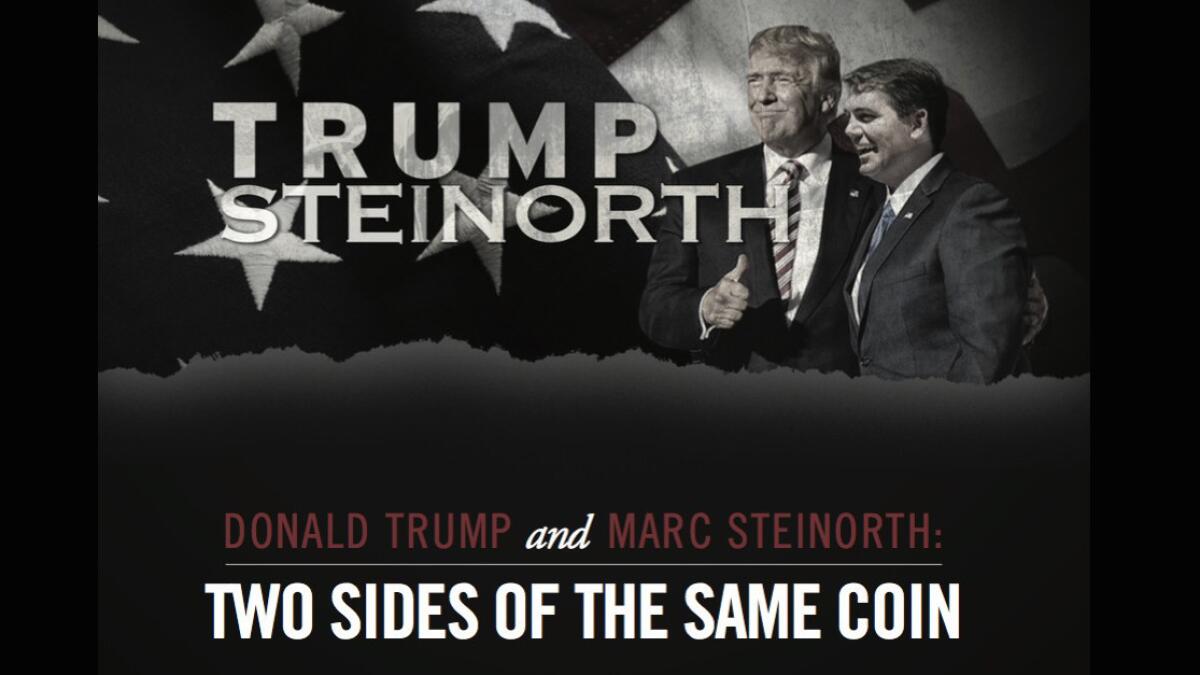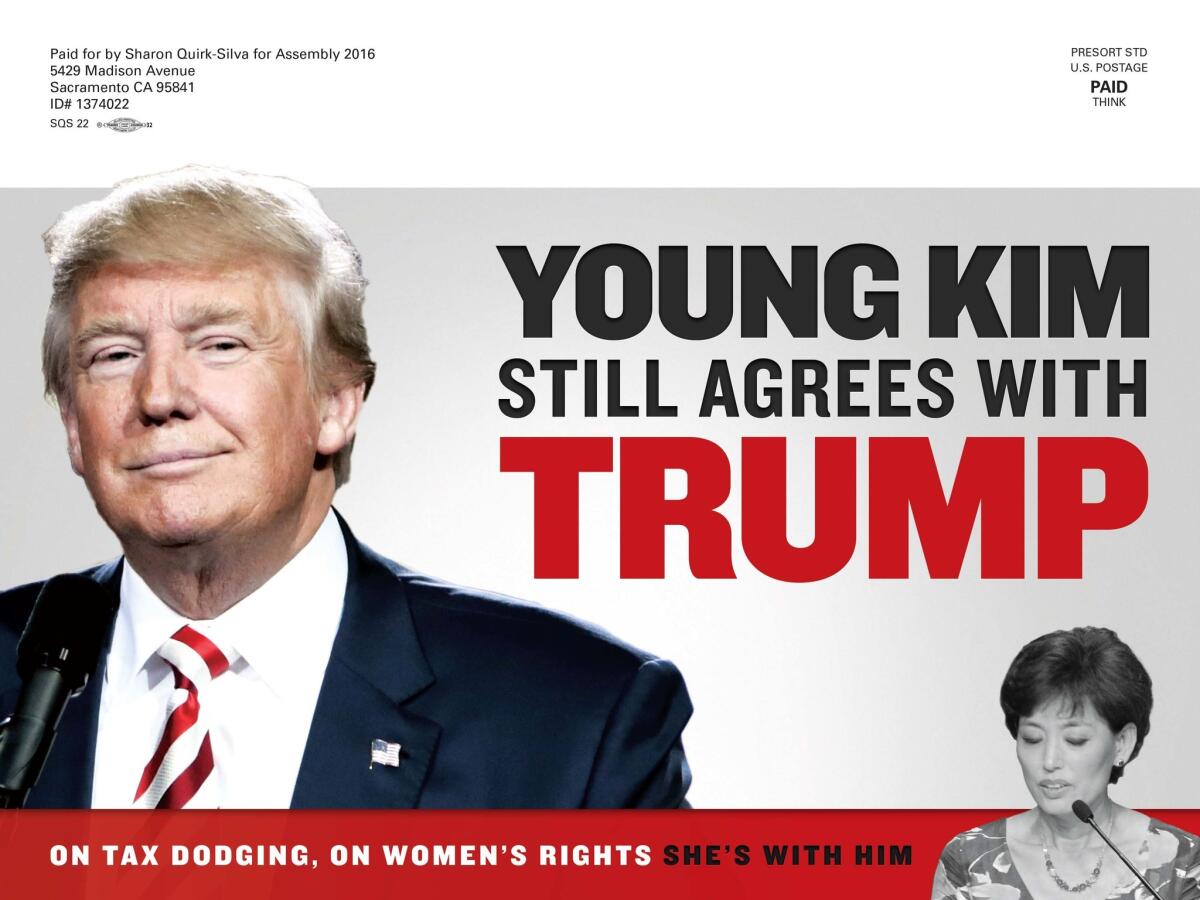California Democrats bet big on an anti-Trump strategy. It didn’t work
- Share via
Although Donald Trump’s victory stunned true-blue California, Democratic strategists in the state are grappling with another reality: Relying on anti-Trump sentiment as a strategy to launch more Democrats into the state Legislature doesn’t appear to have delivered as they’d hoped.
In the final weeks before the election, Democratic party leaders and consultants doubled down on the effort to tie GOP candidates to Trump in campaigns up and down the state, placing his name and image on mailers, television ads and lawn signs.
So far, although it appears Democrats will pick up three seats in the Assembly, there were four races in which the anti-Trump strategy was used and didn’t work. And the Democratic victors appear to be winning by closer margins than pollsters had expected.
“The overall impact was kind of a dud,” said Andrew Acosta, a consultant for Democrat Dawn Ortiz-Legg. In the race for the Assembly, Ortiz-Legg compared her Republican opponent, Jordan Cunningham, to Trump, emphasizing his stances on women’s reproductive issues.
SIGN UP for our free Essential Politics newsletter >>
Ortiz-Legg lost to Cunningham by nearly 10 points in the 35th Assembly District on the Central Coast, despite the fact that state Democrats vastly outspent Republicans to help her.
“We rolled with the Trump hit, and it obviously didn’t have the impact we were hoping it would,” Acosta said.
Assemblywoman Catharine Baker (R-Dublin) survived a challenge from Democrat Cheryl Cook-Kallio, even after her rival took pains to compare the socially moderate Republican to Trump on gun policy and equal pay. Democrats ignored that Baker had said early on she would not vote for Trump. The Republican incumbent won by 12 points even though Democrats enjoy a 12-point advantage in voter registration in her Bay Area district.
The “Trump effect” also failed in Democratic attempts to flip U.S. House seats. The most vulnerable Republican, Rep. Steve Knight of Palmdale, who denounced Trump and said he couldn’t support his party’s nominee, coasted to reelection with an 8-point victory. (After the campaign, Knight said he had voted for Trump, after all.)
The Democratic Congressional Campaign Committee had spent big in an attempt to link Knight to Trump. The strategy also failed in two Central Valley districts.
In Southern California, where the tactic was aggressively pursued, Republican Dante Acosta prevailed in his Assembly race despite his opponent’s frequent efforts to compare him to Trump. Assemblyman Marc Steinorth (R-Rancho Cucamonga) is ahead by 4 points and, if trends hold, will likely hold on to his seat against Democratic challenger Abigail Medina, who called Trump and Steinorth “two sides of the same coin.”

“Honestly, it was just a really lazy way of political consulting,” said Jessica Patterson, CEO of the California Trailblazers program, which grooms Republican candidates for office.
Patterson said the campaign against Acosta and other Republicans was ineffective because the candidates her program recruits are deeply embedded in their communities. “They tried to meld their faces together, called them two peas in a pod. At the end of the day, everyone knows Dante Acosta, the Gold Star father and city councilman for Santa Clarita.”
Assembly Speaker Anthony Rendon (D-Paramount) said he thinks the Trump strategy was effective and that capturing three Assembly seats is no small feat. “We were taking on incumbents. The fact that we knocked off three is remarkable,” Rendon said. “I think we did exceptionally well, and I think that strategy helped.”
But even in the most competitive races where Democrats appear to have come out ahead, they didn’t win by the wider margins that might have been expected in a high-turnout year.
In Orange County, for example, Assemblywoman Young Kim (R-Fullerton) is losing to Democrat Sharon Quirk-Silva. With ballots still being counted, Kim trails by just 1,500 votes in a district that has added more than 14,000 registered Democrats since January alone and where the Democratic voter registration edge has grown to 9 percentage points from less than 2 in 2014. Quirk-Silva made Trump such a central part of her campaign that she filed papers with the FEC as an independent expenditure committee opposing him.

Democrat Al Muratsuchi defeated Assemblyman David Hadley after spending months tying the Republican to Trump through lawn signs and the hadleytrump.com website. Although unofficial results showed Muratsuchi winning the coastal L.A. County district by 6 points, voter registration favors Democrats 41% to 30%, a gap that’s widened by 3 points since two years ago.
Democratic consultant David Jacobson, who said last month it would be “political malpractice” for any down-ballot Democrats not to capitalize on Trump’s dismal approval ratings in California, helped run Medina’s campaign and said polls indicated the anti-Trump message was resonating with independent voters in that race.

But Jacobson added that those models depended on high Democratic turnout in California, typical of presidential election years.
With more than 4 million ballots left to be counted — 1 million of them in Los Angeles County — it’s not entirely clear yet whether Democrats suffered from lower-than-expected voter turnout.
“What we do know,” Acosta said, “is that there are a whole bunch of Republicans that didn’t get knocked out of the state Legislature.”
Times staff writers Javier Panzar and John Myers contributed to this report.
For more on California politics, follow @cmaiduc.
ALSO:
There will be fewer women in California's Legislature in 2017, but number of Latina members grows
Here's why the Legislature's moderate Democrats see the 'Mod Squad' growing on election day
Live California election results
Updates on California politics
UPDATES:
Nov. 14, 1:45 p.m.: This article was updated to reflect that Rep. Steve Knight said after the campaign that he had voted for Trump, despite saying he couldn’t support the GOP nominee.
This article was originally published at 9:20 a.m. on Nov. 13.
Get the L.A. Times Politics newsletter
Deeply reported insights into legislation, politics and policy from Sacramento, Washington and beyond. In your inbox three times per week.
You may occasionally receive promotional content from the Los Angeles Times.








